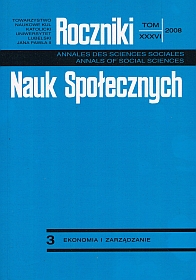Modele wyceny opcji na akcje
Abstrakt
The increase of financial risk that has been observed for more than three decades has brought about the necessity of using new financial solutions increasing the efficiency of protection from the results of unexpected and disadvantageous events. A response to the investors’ new needs was a dynamic development of the market of derivative instruments, including options.
Since investing in options, because of the financial lever, is highly risky, their pricing becomes a particularly significant issue.
The article presents basic, most often applied mathematical models used for defining the value of stock call and put options. They include: the binomial model connected with the names of John Cox, Stephen Ross and Mark Rubinstein, the Black-Scholes model and the Merton model.
In the case of the binomial model two approaches are presented that make it possible to assess the value of options – the one typical of the assumption concerning universal indifference to risk, and the one based on the method of option replication.
According to the Black-Scholes model the price of options is the function of such factors as: the underlying price, the strike price, the time to expiration, the risk-free interest rate, and the volatility of the underlying asset. The Merton model, that is the most popular modification of the Black-Scholes formula, extends it to the case of options run for the shares of the companies constantly paying dividends.
Bibliografia
Appelt K., O różnych podejściach do wyceny opcji. Charakterystyka modeli wyceny opcji sprzed 1973 roku, „Zeszyty Studiów Doktoranckich” 2004, z. 13, s. 5-19.
Cox J., Ross S. A., Rubinstein M., Option Pricing: A Simplified Approach, “Journal of Finance Economic” 7(1979); http://www.in-the-money.com/pages/author.htm
Dębski W., Rynek finansowy i jego mechanizmy, Warszawa: Wydawnictwo Naukowe PWN 2000.
Dziawgo E., Modele kontraktów opcyjnych, Toruń: Wydawnictwo Uniwersytetu Mikołaja Kopernika 2003.
Fierla A., Opcje na akcje, Warszawa: Difin 2004.
Haugen R. A., Teoria nowoczesnego inwestowania, przeł. S. Pająk [i in.], Warszawa: WIG-Pres 1996.
Hull J., Kontrakty terminowe i opcje. Wprowadzenie, przeł. Dąbrowski P., Sobkowiak J., Warszawa: WIG-Press 1999.
Jajuga K., Jajuga T., Inwestycje: instrumenty finansowe, ryzyko finansowe, inżynieria finansowa, Warszawa: Wydawnictwo Naukowe PWN 1997.
Karpoff J. M., Option Pricing Using Binomial Trees, http://faculty.washington.edu/karpoff/FIN%20509/FIN509_session4.ppt
Palczewski A., Wzór Blacka-Scholesa, http://www.mimuw.edu.pl/delta/artykuly/delta1203/wzorbs.pdf
Piontek K., Teoretyczna i rzeczywista wartość walutowych instrumentów pochodnych – rynek polski, http://credit.ae.wroc.pl/~kpiontek/wartpoch.pdf
Smithson Ch. W., Smith, Jr. C. W., Wilford D. S., Zarządzanie ryzykiem finansowym. Instrumenty pochodne, inżynieria finansowa i maksymalizacja wartości, przeł. G. Łuczkiewicz, J. Katolik, Kraków: Oficyna Ekonomiczna 2000.
Sopoćko A., Rynkowe instrumenty finansowe, Warszawa: Wydawnictwo Naukowe PWN 2005.
Taylor F., Rynki i opcje walutowe, przeł. M. Raczyński, Kraków: Oficyna Ekonomiczna 2000.
Wójcicki M., Opcje na GPW, „Rynek Terminowy” 2003, nr 3, s. 6-10.
Copyright (c) 2008 Roczniki Nauk Społecznych

Utwór dostępny jest na licencji Creative Commons Uznanie autorstwa – Użycie niekomercyjne – Bez utworów zależnych 4.0 Międzynarodowe.


